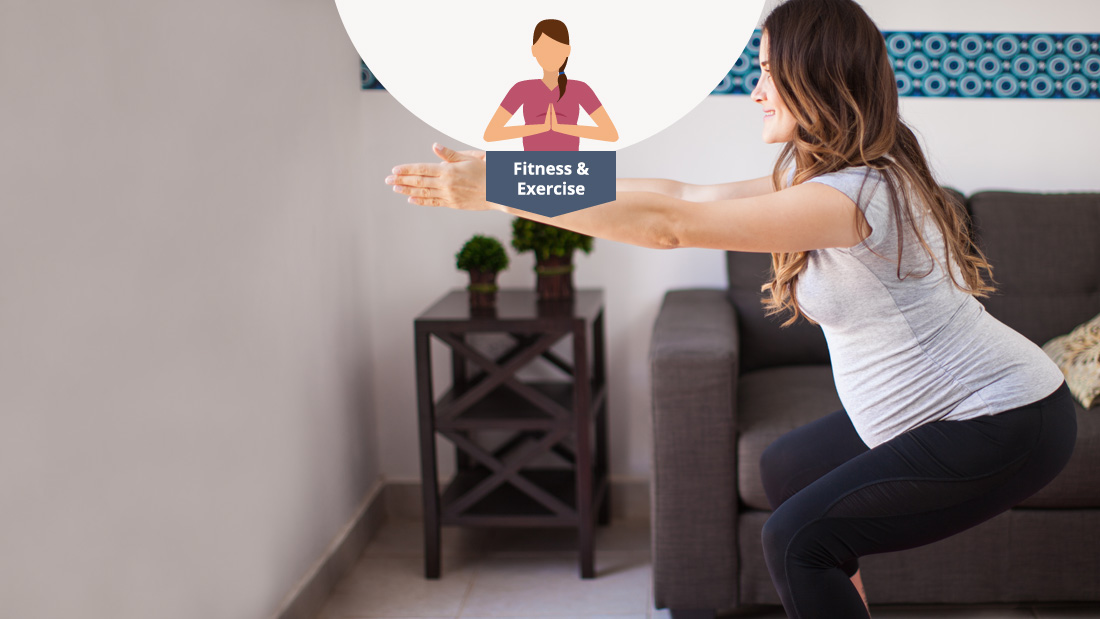
Squatting in the third trimester
Thankfully, some of the most beneficial pregnancy exercises are the simplest. Squats are one such exercise. There’s no need for special equipment or to commit a lot of time to them. All you need is your pregnant self and the determination to get your body fit for labour.
Squats are really great because they help relieve pain in your lower back and pelvis, helping stretch and strengthen these important muscle groups.
And for labour, squatting is often recommended as a good position to help with pushing during the second stage. When you squat, it encourages your pelvis to open, giving your baby more room to pass through and it may help reduce pain during contractions. You’ll also have gravity on your side to make it easier for baby to move down the birth canal.
Be squat ready
Because squatting isn’t the easiest position to maintain, it helps to train your body to be able to comfortably hold the form. Starting squats as early as you can will help strengthen your thighs and help you perfect your technique so you’ll find them easier to do later on.
Always make sure you’re properly supported when doing them if you need it.
Some (but not all) antenatal classes will cover positions for giving birth, in which case the instructor is likely to talk about the importance of squats. If you attend an antenatal class, be sure to make the most of every opportunity to ask your instructor about the best way to squat as well as any other optimum positions for labour.
Performing squats as safely as possible
There are ways of adding a bit more challenge to your squats that are generally considered safe for pregnancy, but these need to be checked with your doctor and are usually safe only in early pregnancy.
For instance, you can use some light free weights in each hand – but using any type of free weights when your bump is large (and therefore at a greater risk of being hit with one of the weights, especially if you’re lifting them overhead) needs to be approached with caution.
In the third trimester, the focus should be on your perfect squat position, so maybe give weights a miss right now. If you’ve already been using free weights throughout your pregnancy, then there’s usually little reason why you won’t be able to continue, but double check with your doctor, and be extra careful.
The best squat exercises to try
When you do a basic squat, it’s important to make sure you have good form so that the right muscles get the workout, allowing you to experience all the intended benefits to the full.
Because your expanding front can sometimes mean your balance is a little off, it will help to do the exercise with a chair in front of you (with the seat pointing away from you). This way you can extend your arms out and use the back of the chair for support.
Start the squat with your feet shoulder width apart. Then, keeping your back straight, lower yourself as far as is comfortable. Hold for 10 seconds and then rise back up to the starting position.
There are some variations you can do, so experiment to find the squatting exercise that you enjoy the most.
Deep squats with pelvic floor contraction – Squatting is a good time to practise your pelvic floor exercises. When you drop into and hold the squat position, squeeze your pelvic floor muscles at the same time. Hold the squat and pelvic floor contraction for about 10 seconds, making sure you continue to breathe normally – don’t hold your breath. Release the muscles as you come back up from the squat. Make sure you keep hold of the chair for extra support.
Wall slide – To support your back and help you maintain proper posture, you can squat with your back against a wall. This is called a wall slide, or wall squat. Simply stand with your back to a wall with your feet shoulder-width apart, placed slightly away from the wall. Slide down into the squat position and hold for a few seconds before rising back up.
Wall slide with a fitness ball – The wall slide can also be performed with the help of a fitness ball. Simply wedge the ball between your back and the wall and hold it in place by leaning on it. As you squat down, the ball will roll down with you. Make sure you have a wall with plenty of space either side so you don’t send ornaments or pictures flying!.
Supported Squat – The Royal College of Midwives Campaign for Normal Birth website recommends the supported squat position during labour. Your partner plays a key role in this exercise, as they’ll be the one offering the support. Have your partner sit in a chair behind you. Stand in front of them, facing away. Slowly squat down, again dropping as low as you can, and lean back towards your partner. They can support you by putting their arms under yours. Practise getting into this position with your partner ready to push your baby out.
Once you find the variation that works best for you, get practising. Ask your midwife for further guidance on how to do your squats properly to ensure you’re getting the maximum benefit, and you’ll be ready for labour in no time.


